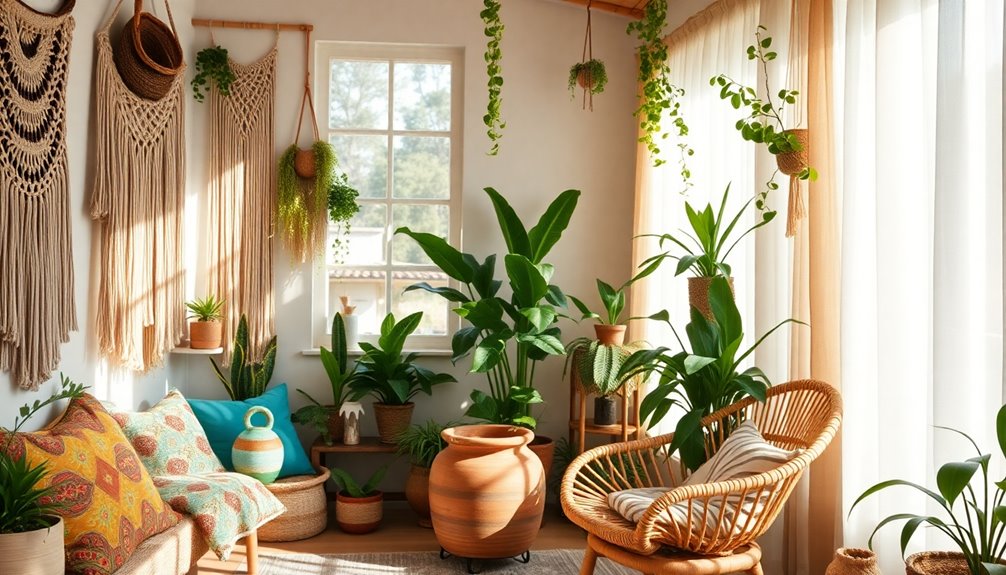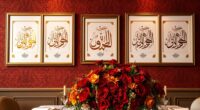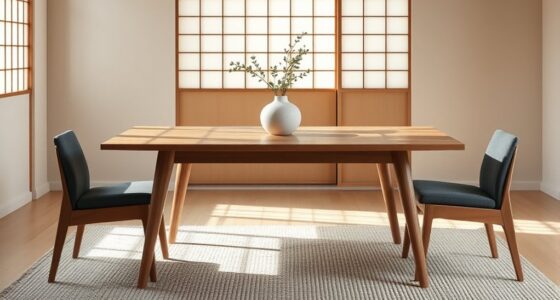Boho art reflects a free-spirited style, celebrating individuality through vibrant colors, natural materials, and eclectic patterns. Originating from the 19th-century Parisian Bohemian scene, it encourages creative expression and challenges conventional norms. You’ll notice the influence of cultural movements, especially from the 1960s hippie era, blending folk elements and a sustainable mindset. Key characteristics include flowy garments, intricate textures, and a connection to nature. This art form emphasizes layering and mixing patterns for a carefree vibe. If you want to explore how to incorporate these unique aesthetics into your life, there’s plenty more to discover.
Key Takeaways
- Boho art embodies creativity, individuality, and freedom, rooted in the historical Bohemian lifestyle of 19th-century Paris artists and intellectuals.
- The style emphasizes vibrant colors, natural fabrics, and intricate textures inspired by nature, promoting a carefree and eclectic aesthetic.
- Women played a crucial role in shaping bohemian culture, challenging traditional gender norms and redefining femininity through their artistic contributions.
- Contemporary boho trends focus on sustainability, blending folk-inspired elements with modern silhouettes while honoring bohemian values of rebellion and creativity.
- The future of boho art integrates eco-friendly practices and digital innovations, enhancing personal expression through layered designs and unique DIY projects.
Historical Origins of Boho Art
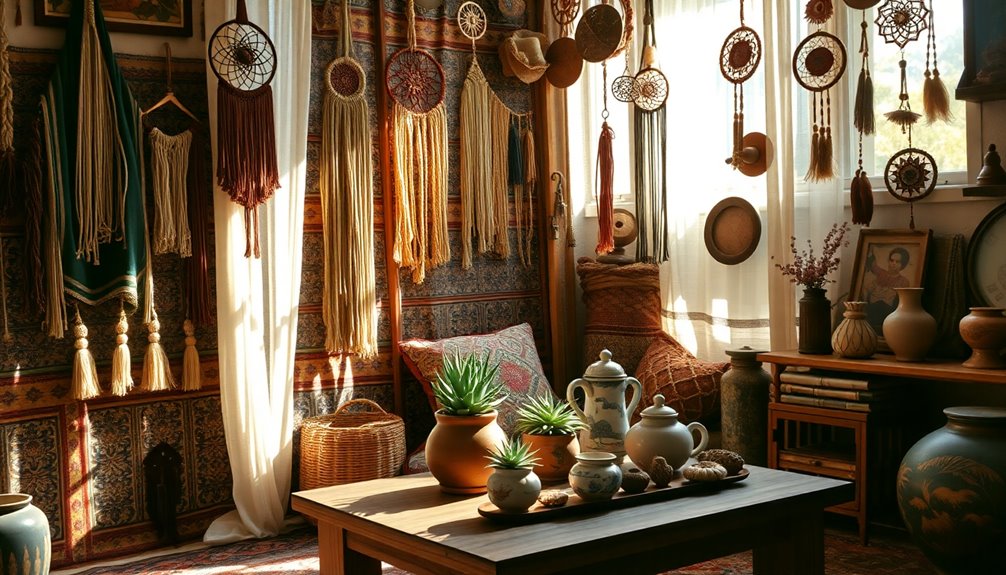
Although the term “Bohemian” originally referred to the Romani people, it quickly evolved to describe the unconventional lifestyles of artists in 19th-century Paris. This movement celebrated creativity and freedom, attracting diverse individuals who resisted mainstream societal norms.
Bohemian enclaves sprouted in major cities, serving as havens for artists and intellectuals seeking a lifestyle that prioritized imagination over convention. Works like Henri Murger’s “Scènes de la vie de bohème” captured this romanticized vision, highlighting a yearning for artistic expression.
In the 1960s, the hippie movement breathed new life into bohemian aesthetics, blending vibrant colors and folk elements, further cementing its legacy as a symbol of counterculture.
Key Characteristics of Boho Style
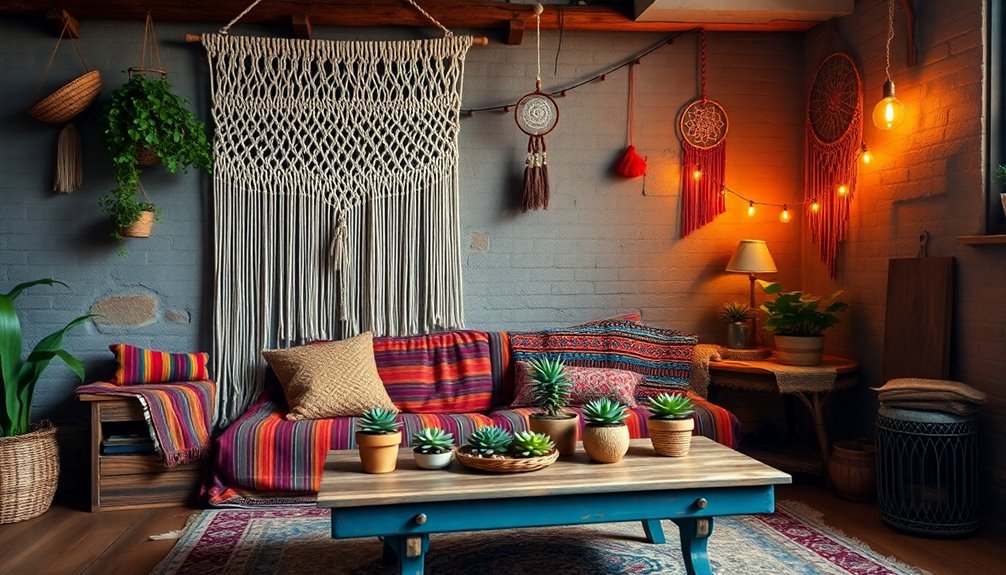
Boho style embodies a vibrant celebration of individuality and creativity, characterized by its eclectic mix of patterns and textures. This fashion trend thrives on personal expression, allowing you to showcase your uniqueness through various elements.
- Embrace natural fabrics like cotton and linen for comfort and sustainability.
- Opt for flowy garments that enhance ease of movement and layering.
- Incorporate vibrant colors and intricate textures inspired by nature.
Accessories are essential in boho style, with statement jewelry made from natural materials becoming focal points in your ensemble.
By mixing floral, paisley, and geometric designs, you create a visually rich palette that reflects your personality. Additionally, consider using layered textiles to enhance the comfort and warmth of your boho-inspired outfits.
With these key elements, you can master the art of boho fashion and celebrate your distinctive style.
Influence of Cultural Movements
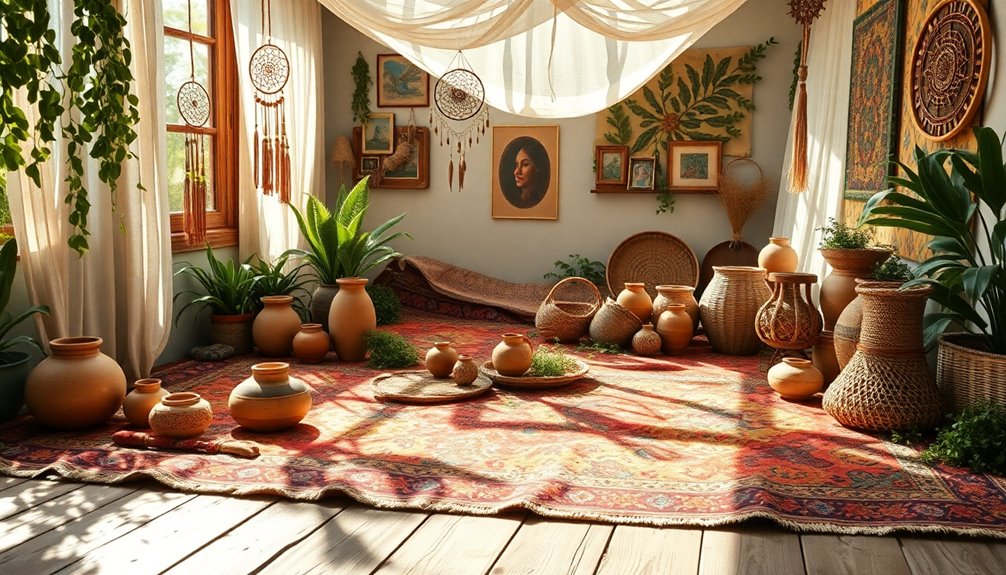
As you explore the influence of cultural movements on boho art, you’ll find that the essence of this style is deeply rooted in the unconventional lifestyles of artists throughout history.
The term “Bohemian” emerged in 19th-century France, symbolizing a free-spirited lifestyle that rebelled against societal norms. This romanticized notion of bohemianism influenced artistic and cultural movements, like the Pre-Raphaelite movement, which blended bohemian ideals with stunning visual art.
Post-World War II, Paris saw a resurgence of colorful and unconventional styles, reflecting the liberation of its people.
Today, contemporary adaptations of boho art showcase elements from diverse cultures, merging folk-inspired designs with modern aesthetics, ensuring the bohemian style remains relevant and vibrant in our ever-evolving fashion landscape. The influence of cultural movements often parallels the emotional expressions seen in various art forms, mirroring the complexities found in mental health dynamics such as those in Borderline Personality Disorder (BPD).
The Role of Women in Bohemianism
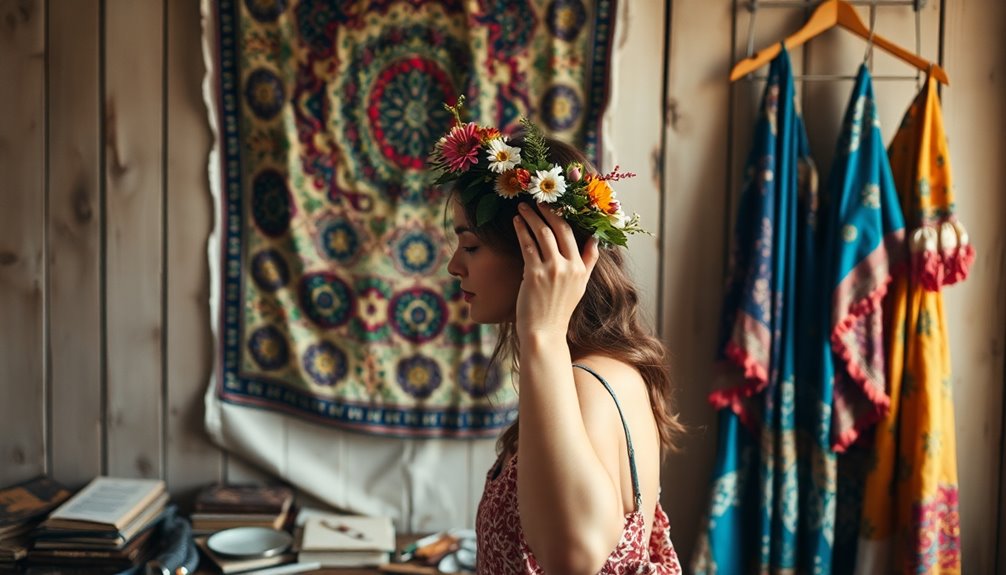
Women played an essential role in shaping the Bohemian movement, especially through the influence of grisettes who challenged traditional gender norms.
By embracing their independence and rejecting societal expectations, they transformed the Parisian artistic scene and inspired others to follow suit.
You’re about to explore how these free-spirited women reshaped cultural narratives and paved the way for future generations.
Grisettes’ Cultural Influence
While the 19th-century Parisian art scene thrived, grisettes emerged as pivotal figures within the Bohemian subculture.
These independent, free-spirited women challenged traditional gender roles and greatly influenced the cultural landscape. Their choice of flowing garments over restrictive fashion norms marked a shift in women’s style, reflecting their embrace of independence.
- Grisettes worked as models, becoming muses for artists.
- They were often romanticized in literature, showcasing their cultural impact.
- Their lifestyle redefined femininity, promoting a new sense of freedom.
Through their artistic contributions and defiance of societal expectations, grisettes shaped the essence of Bohemianism, establishing a legacy that still resonates in modern culture.
Their influence continues to inspire today’s discussions on fashion and gender identity.
Challenging Gender Norms
Grisettes weren’t just muses; they embodied a radical shift in how society viewed women. These independent women of the early 19th-century Parisian Bohemian scene challenged gender norms by embracing freedom and autonomy in both their lives and fashion choices.
| Influence | Description | Impact |
|---|---|---|
| Grisettes | Independent women redefining roles | Cultural shift |
| Jane Morris | Rejected corsets for comfort | Fashion autonomy |
| Rational Dress | Advocated for practical clothing | Feminist alignment |
| Workforce | 300,000 women in diverse careers | Independence growth |
| Marriage Rates | Dropped among educated women | Asserted independence |
This Bohemian spirit encouraged women to break free from societal constraints, paving the way for future generations to assert their style and independence. The rise of narcissistic behavior in societal norms often created additional challenges for women seeking autonomy and self-expression.
Boho Fashion Through the Ages
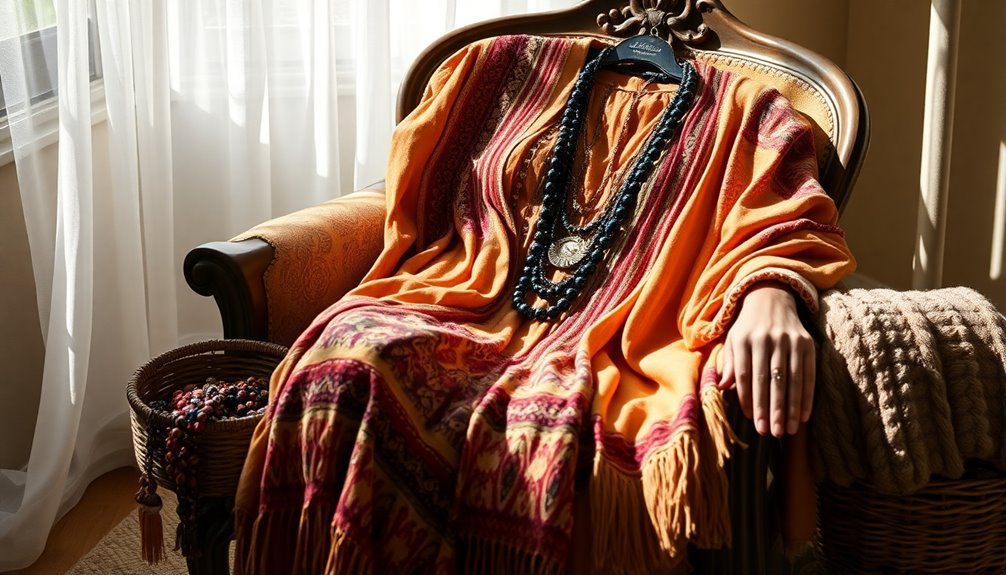
Boho fashion has its roots in the vibrant counterculture of the 1960s and 70s, where it emerged as a bold expression of individuality and freedom. This style, influenced by the bohemian lifestyle of marginalized artists, showcases a carefree vibe that encourages self-expression through eclectic accessories and vintage finds.
Key elements of boho fashion include:
- Flowy garments made from natural fabrics like cotton and linen
- Vibrant floral prints and tribal patterns that celebrate cultural diversity
- A mix of contemporary trends with traditional bohemian pieces
Today, boho fashion continues to evolve while maintaining its core principles. By embracing sustainability and creativity, you can embody the essence of this iconic style, making it uniquely your own.
Boho Art in Interior Design

As you explore the world of interior design, you’ll find that boho art creates inviting spaces that truly reflect your individuality.
The boho aesthetic embraces an eclectic and free-spirited vibe, showcasing vibrant colors and intricate patterns that breathe life into your home. Incorporating natural materials like wood and woven baskets, you enhance warmth while promoting sustainable practices.
Layered textiles and diverse textures add depth, creating personalized spaces that tell your unique story. Artisanal decor, along with handmade items, fosters a rich visual experience that celebrates global influences.
Iconic Figures in Bohemian Art
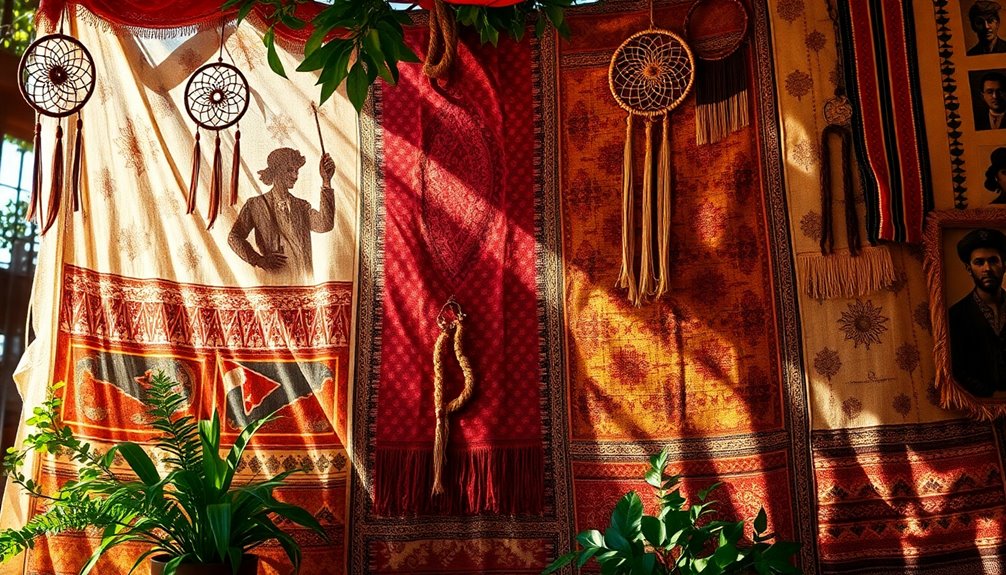
When you think of iconic figures in Bohemian art, names like Dante Gabriel Rossetti and Jane Morris come to mind, each reshaping artistic norms and fashion in their own right.
Their contributions not only influenced the art of their time but also paved the way for future generations to embrace a more vibrant and expressive style.
The cultural impact of these artists continues to resonate, reminding us of the powerful connection between art and identity.
Influential Bohemian Artists
Throughout history, various artists have embraced the Bohemian spirit, blending creativity with a lifestyle that defies convention. Influential artists like Dante Gabriel Rossetti and Jane Morris reshaped perceptions of artistic expression, showcasing how Bohemian fashion and earthy tones could capture the essence of individuality.
In the vibrant New York scene, Jean-Michel Basquiat and Keith Haring challenged norms with their groundbreaking works, adding a mix of textures and socially conscious themes. Françoise Gilot, who coined the term “boho,” highlighted the contrast between traditional luxury and the free-spirited boho flair.
- Rossetti’s art and lifestyle inspired many.
- Morris embodied the essence of Bohemian style.
- Basquiat and Haring pushed boundaries in the 1960s.
Historical Fashion Icons
While many figures have shaped the Bohemian aesthetic, a few iconic fashion icons stand out for their profound influence on both art and style. These individuals embraced artistic freedom and individualism, showcasing unique styles that defined the bohemian wardrobe.
| Icon | Key Contribution | Era |
|---|---|---|
| Jane Morris | Rejected conventional norms, favored flowing fabrics | 19th Century |
| Effie Gray | Used flowers to symbolize self-expression | 19th Century |
| Françoise Gilot | Coined “boho,” emphasizing creativity over luxury | 1960s |
| Janis Joplin | Blended vintage pieces for a vibrant aesthetic | 1960s |
These fashion icons not only influenced fashion trends but also inspired future generations to mix styles and celebrate the essence of boho. The spirit of artistic freedom they embodied resonates with the transformative journeys seen in twin flame unions.
Cultural Impact on Art
Bohemian art embodies the spirit of rebellion and creativity, with iconic figures who broke away from conventional standards to redefine artistic expression.
These artists not only showcased their personal style but also reflected significant cultural shifts, promoting freedom and connection to nature.
- Jean-Michel Basquiat and Keith Haring challenged mainstream culture with vibrant artistic expressions.
- Françoise Gilot’s concept of boho chic influenced contemporary fashion, merging art with lifestyle.
- The post-1944 Paris liberation saw women embracing colorful bohemian styles, symbolizing cultural liberation.
Through their unconventional lifestyles and bold choices, these figures shaped the landscape of art, making bohemian aesthetics a lasting influence in both art and fashion.
Contemporary Boho Trends

As contemporary aesthetics evolve, contemporary boho trends emerge as a vibrant fusion of colorful, folk-inspired elements with streamlined silhouettes.
You’ll notice that these styles focus on comfort and accessibility, catering to modern lifestyles while honoring traditional bohemian values.
Influential fashion icons like Jennifer Lopez showcase how refined boho aesthetics can elevate your wardrobe, enhancing classic elements with chic accessories.
Sustainability is also a key factor; the rise of eco-friendly materials and artisan crafts is reshaping the landscape of boho fashion.
Innovations like NFTs and augmented reality are redefining artistic expression within this trend, allowing you to engage with boho art in exciting new ways.
Embrace these contemporary boho trends to create a unique, stylish look.
Incorporating Boho Aesthetics
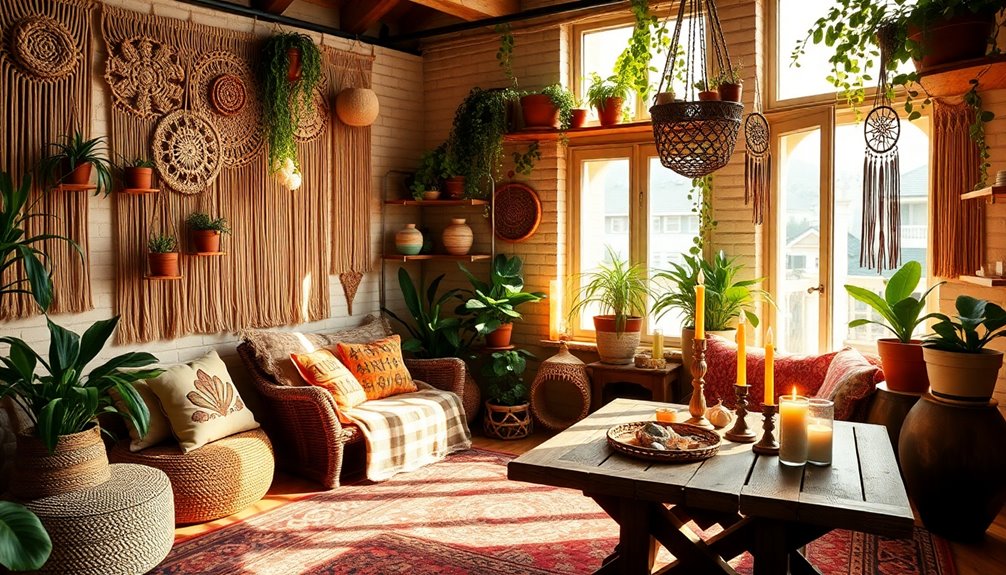
One great way to embrace boho aesthetics is by blending various colors, patterns, and textures that express your individuality.
This bohemian design style encourages you to create a unique personal flair, showcasing your creativity. Incorporating natural materials adds depth and warmth to your space and outfits.
- Use layered jewelry made from natural elements to enhance your look.
- Integrate oversized hats for an effortlessly chic vibe.
- Engage in DIY projects like macrame wall hangings to personalize your home.
Future of Boho Art
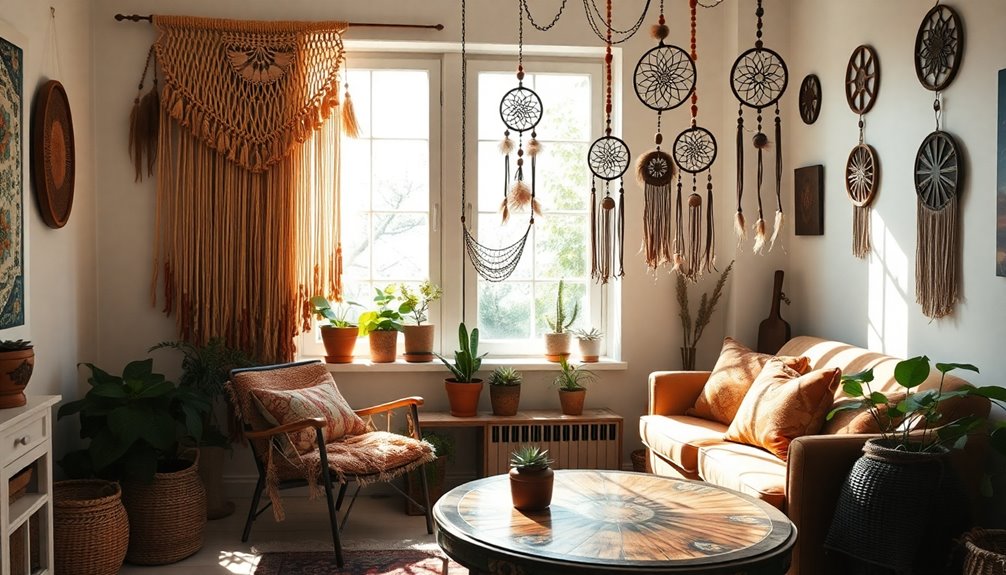
As you look ahead, the future of boho art is set to embrace sustainable fashion innovations that resonate with eco-conscious consumers.
You’ll notice a fascinating blend of digital art integration and cultural fusion trends, creating a vibrant tapestry of expression.
This evolution not only reflects changing values but also opens up exciting new avenues for creativity and connection. Additionally, the focus on renewable energy technologies is expected to influence artistic practices, encouraging artists to incorporate eco-friendly materials and methods into their work.
Sustainable Fashion Innovations
Sustainable fashion innovations are reshaping the future of boho art by integrating eco-friendly materials and ethical practices into its vibrant aesthetic.
You’ll find that sustainable fashion now emphasizes:
- Eco-friendly materials like organic cotton and hemp, promoting environmental consciousness.
- Upcycled fashion that transforms pre-owned garments into unique pieces, showcasing creativity.
- Fair trade practices ensuring artisans receive fair wages, enhancing the cultural significance of boho art.
Additionally, innovations such as biodegradable fabrics and low-impact dyes reflect a commitment to reducing ecological footprints. Essential oils can also play a role in creating natural dyes, further enhancing the sustainability of boho art.
This evolution not only aligns with the bohemian values of individuality but also invites you to embrace a lifestyle that respects the planet.
As you explore this new wave, expect to experience a renewed sense of connection to both art and nature.
Digital Art Integration
While technology continues to advance, it’s transforming the landscape of boho art, making it more accessible and interactive than ever before. Digital art integration is reshaping how you experience this vibrant style. Artists are embracing NFTs to showcase their work authentically, while augmented reality allows you to immerse yourself in boho art within your own space. Social media has become an essential platform for artists, building a global community and promoting environmental consciousness through sustainable practices.
| Aspect | Digital Art Integration | Boho Art Connection |
|---|---|---|
| Medium | NFTs | Ownership & Authenticity |
| Experience | Augmented Reality | Immersive Engagement |
| Community | Social Media | Shared Aesthetics |
Cultural Fusion Trends
The evolution of boho art is increasingly driven by cultural fusion, blending traditional techniques and motifs from diverse backgrounds into contemporary pieces that resonate worldwide.
This trend not only celebrates individuality but also embraces sustainable practices, emphasizing the use of eco-friendly materials.
- Artists are creating unique contemporary pieces that reflect global cultural elements.
- Digital platforms expand the reach of bohemian art, allowing for international collaboration and diverse influences.
- Innovative expressions, such as NFTs and augmented reality, redefine how we experience and value boho art.
As you explore this vibrant landscape, you’ll find that the future of boho art isn’t just about aesthetics—it’s about connection, creativity, and a shared commitment to sustainability.
Frequently Asked Questions
What Is the Meaning of Boho Art?
When you think about the meaning of boho art, it’s all about embracing individuality and creativity. This style encourages you to express yourself through vibrant colors, intricate patterns, and diverse textures.
You’ll find that boho art draws inspiration from various cultures, making it a unique blend of handmade items and natural elements. It’s a celebration of free-spirited living, allowing you to connect with your artistic side and explore your personal journey.
What Is the Meaning of Boho Style?
Boho style represents a celebration of individuality and creativity.
You’ll notice its vibrant colors, intricate patterns, and relaxed, eclectic vibe. This aesthetic encourages you to express yourself freely through flowing garments, layered outfits, and unique accessories.
By incorporating global influences and artisanal pieces, you embrace sustainability and ethical consumption.
Ultimately, it’s about creating a personal style that reflects your free spirit, making each outfit a statement of who you are.
What Does Boho Symbolize?
When you think about boho, it’s not just a style; it’s a statement.
This eclectic aesthetic symbolizes freedom, creativity, and individuality, encouraging you to embrace your unique identity. It’s about breaking away from conventional norms and celebrating diversity.
You’ll find vibrant colors and intricate patterns that reflect a rich history of artistic rebellion.
Ultimately, boho invites you to express yourself authentically and connect with a community that values personal expression above all.
What Are the Elements of Boho Style?
When you explore the elements of boho style, you’ll notice an eclectic mix of patterns and textures.
You’ll love the loose-fitting garments like maxi dresses and jumpsuits that offer comfort.
Accessories are key, so layer necklaces and wear oversized hats to enhance your look.
Earthy tones and vibrant hues will catch your eye, reflecting nature’s beauty.
Don’t forget comfortable footwear like flat sandals or ankle boots to complete your effortlessly chic vibe!
Conclusion
At its core, Boho art is like a vibrant tapestry, woven from threads of history, culture, and individuality. As you embrace its eclectic spirit, you’re not just decorating your space; you’re telling a story that transcends time. Each piece symbolizes freedom and creativity, inviting you to break away from the ordinary. As you explore contemporary trends, remember that the heart of Bohemianism beats in your choices, blending the past with your unique vision for the future.
